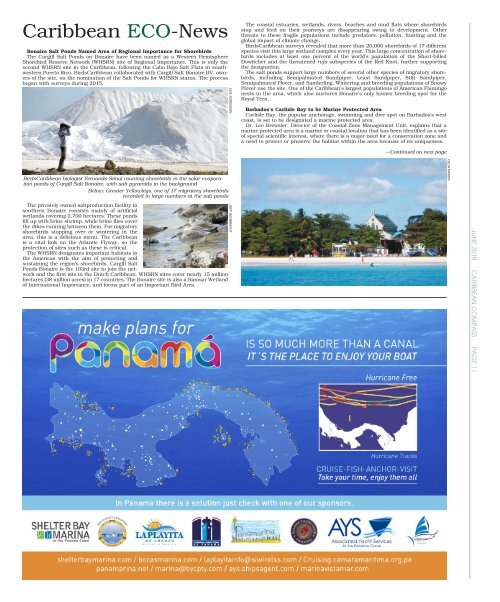Caribbean Compass Yachting Magazine - June 2018
Welcome to Caribbean Compass, the most widely-read boating publication in the Caribbean! THE MOST NEWS YOU CAN USE - feature articles on cruising destinations, regattas, environment, events...
Welcome to Caribbean Compass, the most widely-read boating publication in the Caribbean! THE MOST NEWS YOU CAN USE - feature articles on cruising destinations, regattas, environment, events...
Create successful ePaper yourself
Turn your PDF publications into a flip-book with our unique Google optimized e-Paper software.
<strong>Caribbean</strong> ECO-News<br />
Bonaire Salt Ponds Named Area of Regional Importance for Shorebirds<br />
The Cargill Salt Ponds on Bonaire have been named as a Western Hemisphere<br />
Shorebird Reserve Network (WHSRN) site of Regional Importance. This is only the<br />
second WHSRN site in the <strong>Caribbean</strong>, following the Cabo Rojo Salt Flats in southwestern<br />
Puerto Rico. Birds<strong>Caribbean</strong> collaborated with Cargill Salt Bonaire BV, owners<br />
of the site, on the nomination of the Salt Ponds for WHSRN status. The process<br />
began with surveys during 2015.<br />
Birds<strong>Caribbean</strong> biologist Fernando Simal counting shorebirds in the solar evaporation<br />
ponds of Cargill Salt Bonaire, with salt pyramids in the background<br />
Below: Greater Yellowlegs, one of 17 migratory shorebirds<br />
recorded in large numbers at the salt ponds<br />
The privately owned saltproduction facility in<br />
southern Bonaire consists mainly of artificial<br />
wetlands covering 2,700 hectares. These ponds<br />
fill up with brine shrimp, while brine flies cover<br />
the dikes running between them. For migratory<br />
shorebirds stopping over or wintering in the<br />
area, this is a delicious menu. The <strong>Caribbean</strong><br />
is a vital link on the Atlantic Flyway, so the<br />
protection of sites such as these is critical.<br />
The WHSRN designates important habitats in<br />
the Americas with the aim of protecting and<br />
sustaining the region’s shorebirds. Cargill Salt<br />
Ponds Bonaire is the 103rd site to join the network<br />
and the first site in the Dutch <strong>Caribbean</strong>. WHSRN sites cover nearly 15 million<br />
hectares (38 million acres) in 17 countries. The Bonaire site is also a Ramsar Wetland<br />
of International Importance, and forms part of an Important Bird Area.<br />
LISA SORENSON JEFF GERBRACHT<br />
The coastal estuaries, wetlands, rivers, beaches and mud flats where shorebirds<br />
stop and feed on their journeys are disappearing owing to development. Other<br />
threats to these fragile populations include predators, pollution, hunting and the<br />
global impact of climate change.<br />
Birds<strong>Caribbean</strong> surveys revealed that more than 20,000 shorebirds of 17 different<br />
species visit this large wetland complex every year. This large concentration of shorebirds<br />
includes at least one percent of the world’s population of the Short-billed<br />
Dowitcher and the threatened rufa subspecies of the Red Knot, further supporting<br />
the designation.<br />
The salt ponds support large numbers of several other species of migratory shorebirds,<br />
including Semipalmated Sandpiper, Least Sandpiper, Stilt Sandpiper,<br />
Semipalmated Plover, and Sanderling. Wintering and breeding populations of Snowy<br />
Plover use the site. One of the <strong>Caribbean</strong>’s largest populations of American Flamingo<br />
nests in the area, which also nurtures Bonaire’s only known breeding spot for the<br />
Royal Tern.<br />
Barbados’s Carlisle Bay to be Marine Protected Area<br />
Carlisle Bay, the popular anchorage, swimming and dive spot on Barbados’s west<br />
coast, is set to be designated a marine protected area.<br />
Dr. Leo Brewster, Director of the Coastal Zone Management Unit, explains that a<br />
marine protected area is a marine or coastal location that has been identified as a site<br />
of special scientific interest, where there is a major need for a conservation zone and<br />
a need to protect or preserve the habitat within the area because of its uniqueness.<br />
—Continued on next page<br />
CELIA MASON<br />
JUNE <strong>2018</strong> CARIBBEAN COMPASS PAGE 11


















